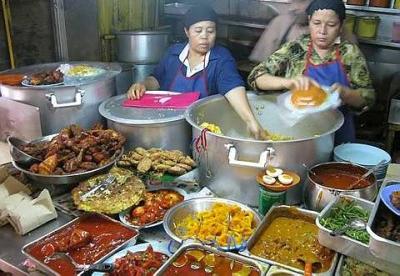Malaysian Cuisine (Food)
This section of our web sites presents some of the Authentic cuisines from Malaysia. One in Malaysia you can try any of these dishes at your hotel or can even try them in the real life in bazaars o along the highway journey.
Local Malay cuisine
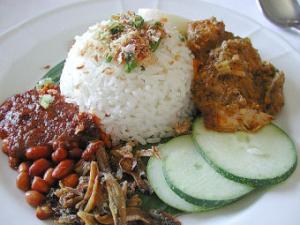 Nasi lemak with sambal ikan bilis (curried dry anchovies), cucumber,
chicken curry, pork floss and an eggThe Malays were Malaysia's original
inhabitants and their distinctive cuisine is popular to this day. Characterized
by heavy use of spices, most Malay dishes are curries, stews or dips of one kind
or another and nasi kandar restaurants, offering a wide variety of these to
ladle onto your rice, are very popular.
Nasi lemak with sambal ikan bilis (curried dry anchovies), cucumber,
chicken curry, pork floss and an eggThe Malays were Malaysia's original
inhabitants and their distinctive cuisine is popular to this day. Characterized
by heavy use of spices, most Malay dishes are curries, stews or dips of one kind
or another and nasi kandar restaurants, offering a wide variety of these to
ladle onto your rice, are very popular.
Nasi lemak (lit. "creamy rice") is the definitive Malay breakfast, consisting at its simplest of rice cooked in light coconut milk or coconut cream, some ikan bilis (anchovies), peanuts, a slice of cucumber and a dab of chilli on the side. A larger fried fish or chicken wing are common accompaniments. More often than not, also combined with a variety of curries and/or sambal (see below).
Rendang, occasionally dubbed "dry curry", is meat stewed for hours on end in a spicy (but rarely fiery) curry paste until almost all water is absorbed. Beef rendang is the most common, although chicken and mutton are spotted sometimes.
Sambal is the generic term for chilli sauces of many kinds. Sambal belacan is a common condiment made by mixing chilli with the shrimp paste belacan, while the popular dish sambal sotong consists of squid (sotong) cooked in red chilli sauce. Sambal ikan bilis, a common accompaniment to nasi lemak, consists of small dried fish with onions, chilli and sugar.
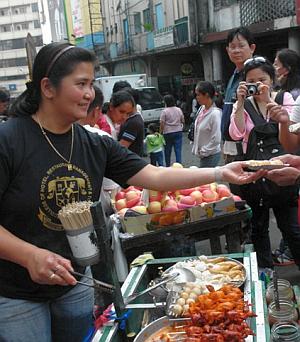 Satay are barbecued skewers of meat, typically chicken or beef. What
separates satay from your ordinary kebab is the slightly spicy peanut-based
dipping sauce.
Satay are barbecued skewers of meat, typically chicken or beef. What
separates satay from your ordinary kebab is the slightly spicy peanut-based
dipping sauce.
Mee rebus is egg noodles served in some sweet chilli-based broth, usually with a slice of hard boiled egg and some lime.
Acar (achar) is thinly sliced vegetables and fruits (cucumber, carrot, pineapple) lightly pickled with vinegar, chilli and peanuts, a common side dish. Nowhere near as pungent as the Indian pickle of the same name.
Malay Deserts
Malay desserts, especially the sweet pastries and jellies (kuih or kueh) made largely from coconut and palm sugar (gula melaka, named after Melaka), bear a distinct resemblance to those of Thailand. But in the sweltering tropical heat, try one of many concoctions made with ice instead:
Bubur cha-cha consists of cubed yam, sweet potato and sago added into coconut milk soup. This can be served warm or cold.
Chendol is made with green pea noodles, kidney beans, palm sugar and coconut milk.
Durian is not exactly a dish, but a local fruit with distinctive odor you can smell a mile away and a sharp thorny husk. Both smell and taste defy description, but eating garlic ice cream next to an open sewer comes to mind. If you are game enough you should try it, but be warned beforehand � you will either love it or hate it. The rich creamy yellow flesh is often sold in street markets conveniently in pre-packaged packs, for anywhere from RM1 for a small fruit all the way up to RM50/kg depending on the season and type of durian. This 'king of fruits' is also made into ice cream, cakes, sweets and other decadent desserts. Note: You're not allowed to carry durians on public transport and they're banned from many hotels.
Ais kacang literally means "ice bean" in Malay, or in another name of ABC means Air Batu Campur, is a good clue to the two major ingredients: shaved ice and sweet red beans. However, more often than not you'll also get gula melaka (palm sugar), grass jelly, sweet corn, attap palm seeds and anything else on hand thrown in, and the whole thing is then drizzled with canned condensed milk or coconut cream and colored syrups. The end result tastes very interesting � and refreshing.
Kuih (or kueh) refer to a plethora of steamed cake-like, mostly made with coconut milk, grated coconut flesh, glutinous rice or tapioca. They are often very colorful and cut into fanciful shapes, but despite their wildly varying appearance tend to taste rather similar.
Peranakan/Nonya cuisine
The most identifiable cuisine in the region is Peranakan or Nonya cuisine, born from the mixed Malay and Chinese communities of what were once the British colonies of the Straits Settlements (modern-day Singapore, Penang and Malacca).
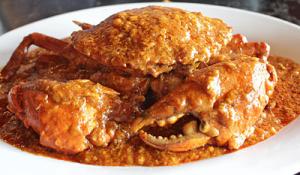 Chilli crab is a whole crab ladled with oodles of sticky, tangy chilli
sauce. Notoriously difficult to eat but irresistibly delicious: don't wear a
white shirt! For a less messy but equally tasty alternative, ask for black
pepper crab.
Chilli crab is a whole crab ladled with oodles of sticky, tangy chilli
sauce. Notoriously difficult to eat but irresistibly delicious: don't wear a
white shirt! For a less messy but equally tasty alternative, ask for black
pepper crab.
Kaya is a jam-like spread made from egg and coconut, an odd-sounding but tasty combination. Served on toast for breakfast, canonically accompanied by runny eggs and strong, sweet coffee (kopi).
Laksa in Malaysia comes in many wildly different styles, and every state seems to have its signature style. Laksa lemak is a fragrant soup of noodles in a coconut-based curry broth, topped with cockles or shrimp, while Penang's assam laksa is made with a tamarind-infused broth instead of coconut, and has a spicy sourish taste. Kelantanese laksam, on the other hand, comes with wide, flat rice noodles and a very coconutty broth.
Mee siam is rice flour noodles served with sour gravy made from
tamarind, dried shrimp and fermented beans. Usually served with tau pok (bean
curd) cubes and hard boiled eggs.
Popiah or spring rolls come fresh or fried. They consist of boiled turnips,
fried tofu, fried shallots and garlic, chopped omelette, chopped stir fried long
beans and (optional) chilli sauce, wrapped in a thin rice skin covering and
eaten like a fajita.
Rojak means a mixture of everything in Malay, and there are two very different types. Chinese rojak is a salad of pineapple, white turnip, cucumber, tau pok (fried bean curd) with thin tiny slices of bunga kantan (torch ginger flower buds), tossed in shrimp paste sauce and sugar, then sprinkled with crushed peanuts. Indian rojak consists of mainly fried fritters made from flour and various pulses with cucumber and tofu, with sweet & spicy sauces.
Satay bee hoon is rice vermicelli (bee hoon) served with the same
peanut and chilli sauce used for satay, hence the name. Usually see hum
(cockles), dried squid and pork slices are added in.
Besides these dishes, the Peranakans are also known for their kueh or snacks
which are somewhat different from the Malay versions due to stronger Chinese
influences.
Chinese cuisine
Chinese food as eaten in Malaysia commonly originates from southern China, particularly Fujian and Guangdong. While "authentic" fare is certainly available, especially in fancier restaurants, the daily fare served on the streets has absorbed a number of tropical touches, most notably the fairly heavy use of chilli and the Malay fermented shrimp paste belachan as condiments. Noodles can also be served not just in soup (tang), but also "dry" ( kan), meaning that your noodles will be served tossed with chilli and spices in one bowl, and the soup will come in a separate bowl.
Bak chor mee is essentially noodles with minced pork, tossed in a chilli-based sauce with lard, ikan bilis (fried anchovies), vegetables and mushrooms.
Bak kut teh, lit. "pork bone tea", is a simple-sounding soup of pork ribs simmered for hours in broth until they're ready to fall off the bone. It's typically eaten with white rice, mui choy (pickled vegetables) and a pot of strong Chinese tea, hence the name � the broth itself doesn't contain any tea. To impress the locals, order some you tiao fritters from a nearby stall and cut them up into bite-sized chunks to dip into your soup. The port town of Klang is said to be original home of the dish.
Char kui teow is a favourite noodle type at Penang. Some flat egg noddle fried with soya source, prawn, clam, sprout bean & bak you (Pork's Oil).
Chee cheong fun is a favorite breakfast consisting of lasagna-type rice noodles rolled up and various types of fried meats including fishballs and fried tofu. The dish is usually topped with a generous amount of sauce.
Chwee kway is a dish consisting of rice cakes topped with chai po
(salted fermented turnips), usually served with some chilli sauce.
Fish ball noodles come in many forms, but the type most often seen is mee pok,
which consists of flat egg noodles tossed in chilli sauce, with the fishballs
floating in a separate bowl of soup on the side.
Hainanese chicken rice is steamed chicken served with special gently spiced rice and tasty ginger and chilli dipping sauces. The chicken doesn't taste like much, the secret is in the rice and the sauces! Malacca and Muar, Johor have a variant in which the rice is cooked until it is sticky and made into a ball.
Hokkien mee refers to at least three separate dishes. In Kuala Lumpur, this gets you thick noodles fried in dark soy sauce, while in Penang you'll get a very spicy shrimp soup. Interestingly, neither of them bear any resemblance to the dish of the same name served in neighbouring Singapore.
Kway chap is essentially sheets made of rice flour served in some brownish soup, accompanied by a plate of braised pork and pig organs (usually intestines).
Lok-lok consists of skewers of fish, meat and vegetables, cooked in boiling broth and eaten with sauces.
Steamboat , also known as hot pot, is do-it-yourself soup Chinese style. You get a pot of broth bubbling on a tabletop burner, pick meat, fish and veggies to your liking from a menu or buffet table, then cook it to your liking. When finished, add in noodles or ask for rice to fill you up. This usually requires a minimum of two people, and the more the merrier.
Wantan mee is thin noodles topped with wantan dumplings of seasoned minced pork. Unlike the soupy Hong Kong version, it is usually served dry.
Yong tau foo literally means "boiled tofu", but it's more exciting than it sounds. The diner selects their favorites from a vast assortment of tofu, fish paste, seafood and vegetables and they are then sliced into bite-size pieces, cooked briefly in boiling water and then served either in broth as soup or "dry" with the broth in a separate bowl. The dish can be eaten by itself or with any choice of noodles. Essential accompaniments are spicy chili sauce and a distinctive brown sweet sauce for dipping.
Indian cuisine
The smallest of Malaysia's 'Big 3', the Indians have had a disporportionately large impact on the culinary scene, with the mamak (Indian Muslim, see below) stall being a fixture in every Malaysian city. Authentic Indian food in Malaysia includes south Indian typical meals such as dosai, idli, sambar, and others, as well as north Indian meals including various curries, naan bread, and more. In addition, however, a number of Indian dishes have been "Malaysianized" and adopted by the entire population, including:
Fish head curry is, true to the name, a gigantic curried fish head cooked whole until it's ready to fall apart. The head itself is not eaten, as there's plenty of meat to be found inside and all around. Note that there are two distinct styles, the fiery Indian and the milder Chinese kind.
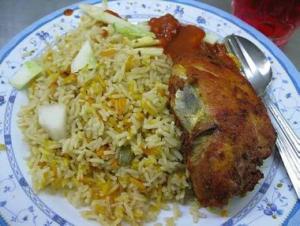 Nasi briyani is rice cooked in turmeric, giving it an orange colour.
Unlike the Hyderabadi original, it's usually rather bland, although specialist
shops do turn out more flavorful versions. It is usually served with curry
chicken and some Indian crackers.
Nasi briyani is rice cooked in turmeric, giving it an orange colour.
Unlike the Hyderabadi original, it's usually rather bland, although specialist
shops do turn out more flavorful versions. It is usually served with curry
chicken and some Indian crackers.
Roti canai is the local version of paratha, flat bread tossed in the air like pizza, rapidly cooked in oil, and eaten dipped in curry. Variations include include roti kosong (plain), roti telur (with egg) and murtabak (layered with chicken, mutton or fish), roti boom (with condensed milk) and roti tisu (made very thin like tissue paper).
Putu mayam is composed of some vermicelli-like noodles usually mixed with shredded coconut and some jaggery.
East Malaysia Cuisine
East Malaysia, especially Sarawak, also offers a wide range of local dishes,
but these are very rarely seen in peninsular Malaysia. See Sarawak#Eat for
details.
History of Malaysia
Festivals in Malaysia
Malaysian Cuisine




